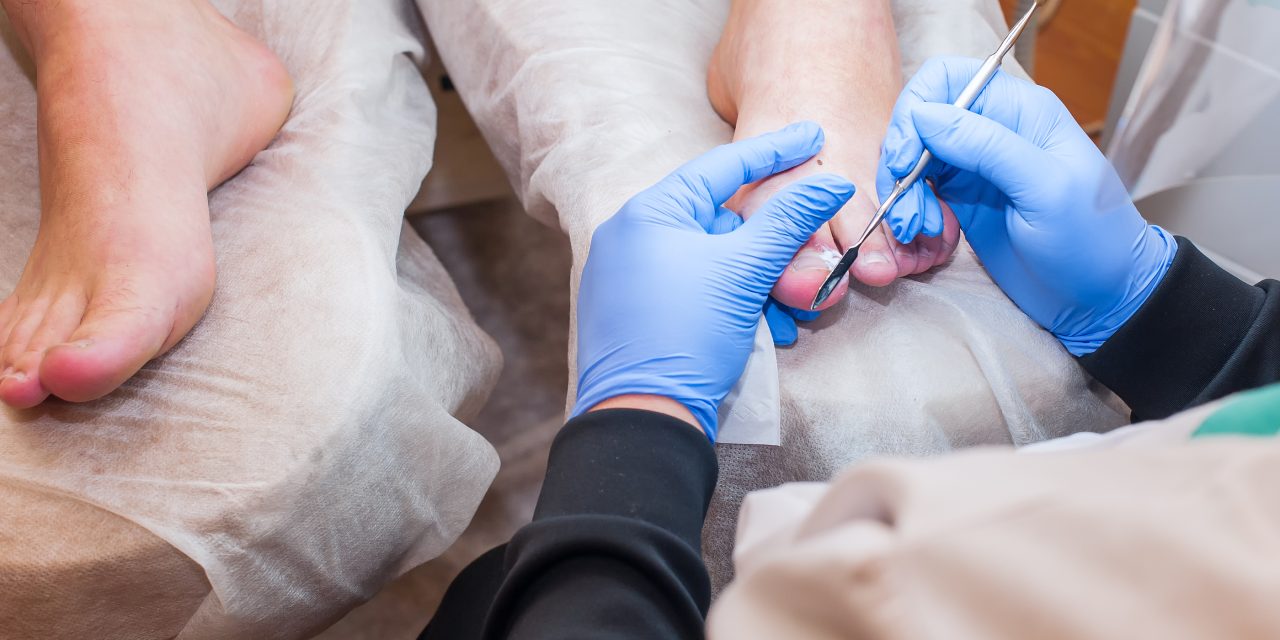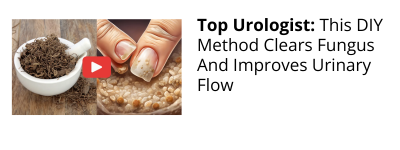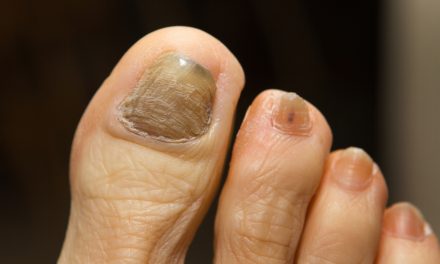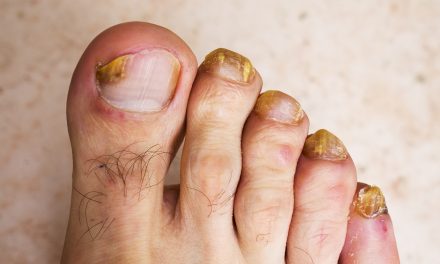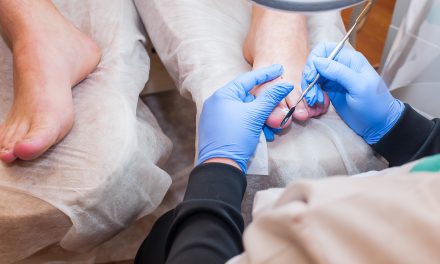Toenail fungus, also known as onychomycosis, is a common condition that affects millions of people worldwide. This persistent and often embarrassing issue can cause discomfort, discoloration, and thickening of the nails, making it difficult for many to confidently wear sandals or walk barefoot in public. With numerous treatments available, determining the best option to address this condition can be a challenge for those affected.

There are various toenail fungus treatments that aim to eliminate the fungi responsible and restore the nail’s appearance. These treatments include over-the-counter remedies, prescription medications, laser therapy, surgery, and home-based natural solutions. As toenail fungus varies in severity and can be caused by different types of fungi, the treatment’s effectiveness depends on the individual’s specific situation.
Key Takeaways
- Toenail fungus is a widespread issue causing discomfort and aesthetic concerns for millions of people.
- Numerous treatments exist to target and eliminate fungi and improve the toenail’s appearance.
- The best treatment for toenail fungus depends on the individual’s specific condition and circumstances.
Understanding Toenail Fungus

Toenail fungus, also known as onychomycosis, is a common condition that affects millions of people worldwide. This fungal infection is caused by a variety of fungi that thrive in the moist and warm environment of shoes and socks. To better understand toenail fungus, it is essential to know its causes, symptoms, and treatment options.
Causes:
Fungi are everywhere, making it easy for toenail fungus to occur. The primary causes include:
- Exposure to damp environments, such as public showers or swimming pools
- Wearing tight and poorly ventilated shoes for prolonged periods
- Skin injury near the nail bed
- A weakened immune system
- Preexisting tinea pedis (athlete’s foot) infection
Symptoms:
Toenail fungus often begins as a small white or yellow spot under the nail. As the infection progresses, the following changes in the toenail may occur:
- Discoloration (yellow, brown, or white)
- Thickness or brittleness
- Foul smell
- Crumbling of the nail
- Pain when pressure is applied to the infected nail
It is crucial to address these symptoms early to avoid more severe complications, such as complete loss of the toenail and spreading of the infection to other nails.
Treatment Options:
There are several treatment options for toenail fungus, including over-the-counter (OTC) medication, prescription drugs, and alternative therapies. Here is a brief overview:
| Treatment Type | Description | Pros | Cons |
|---|---|---|---|
| OTC Topicals | Antifungal creams, ointments, or nail polishes applied directly to the affected nail. | Easy to use and inexpensive | May not be as effective for severe infections |
| Prescription Oral Medication | Antifungal pills prescribed by a doctor. | Highly effective | Potential side effects, such as liver damage or rash |
| Prescription Topicals | Stronger medicated creams, ointments, or nail polishes prescribed by a doctor. | Targeted treatment | Less effective than oral medication |
| Alternative Therapies | Home remedies or natural treatments like tea tree oil or Vicks VapoRub. | Minimal side effects | Limited scientific evidence for their effectiveness |
In conclusion, understanding the causes, symptoms, and treatment options for toenail fungus is crucial to effectively address the infection. Early intervention can provide the best chances for a successful outcome and prevent further complications.
Common Signs and Symptoms
Toenail fungus, also known as onychomycosis, is a common condition that affects millions of people worldwide. Identifying the signs and symptoms early is essential for successful treatment. Here are the most common indicators of toenail fungus:
- Discoloration: Toenails may become yellow, brown, or even black. In some cases, white patches may also appear.
- Thickening: Affected toenails often become thick and difficult to cut.
- Brittle or crumbling: Fungal-infected toenails may become fragile, and can easily crumble or break.
Additionally, there are several other factors to consider:
- Odor: Infected toenails can emit a foul smell.
- Distorted shape: Toenails may become distorted, twisted, or deformed due to fungus.
- Pain: In some cases, pain can accompany toenail fungus, especially if left untreated and the infection spreads.
| Sign | Description |
|---|---|
| Discoloration | Yellow, brown, white, or black toenails |
| Thickening | Toenails become thicker and harder to cut |
| Brittle | Toenails easily crumble or break |
| Odor | Foul smell from the infected toenail(s) |
| Distorted shape | Toenails may change shape or become deformed |
| Pain | Accompanies infection, worsens if left untreated |
It’s important to remember that these symptoms can vary and may not all be present. Additionally, symptoms can be similar to other nail conditions, so it’s essential to consult a healthcare professional for an accurate diagnosis. Early detection and intervention are key to successfully treating toenail fungus and preventing future infections.
Over-the-Counter Treatments
Over-the-counter treatments are a popular choice for individuals seeking relief from toenail fungus. These products can be found at pharmacies and online retailers, and generally provide an affordable, non-invasive solution. This section will cover four popular categories: antifungal creams, antifungal nail polishes, ointments, and medicated foot soaks.
Antifungal Creams
Antifungal creams are formulated to penetrate the nail and attack the fungus residing underneath. Some popular active ingredients found in these creams include:
- Terbinafine: Effective against most fungal infections, but may require an extended treatment period.
- Clotrimazole: A common choice for mild to moderate infections, with limited side effects.
- Miconazole: Another popular option with broad-spectrum antifungal properties.
Antifungal Nail Polishes
Antifungal nail polishes aim to treat mild to moderate infections while maintaining an inconspicuous appearance. Many products require daily application and extended treatment periods. Examples of active ingredients in these products are:
- Amorolfine: Effective against a range of fungi, but often requires a longer treatment time.
- Ciclopirox: A broad-spectrum antifungal that can be effective in mild cases, though recurrence rates can be high.
Ointments
Ointments, such as balms or salves, provide a concentrated treatment at the nail’s surface. While penetration of the nail can be limited, ointments deliver potent antifungal ingredients that can alleviate symptoms and clear up infections. Some common antifungal ointment ingredients include:
- Undecylenic acid: A natural compound derived from castor oil that is effective against various fungal strains.
- Tolnaftate: A synthetic agent with a long history of use in treating fungal infections.
Medicated Foot Soaks
Medicated foot soaks can provide relief and promote healing by softening the nail, allowing for better penetration of other treatments. Common ingredients in these soaks include:
- Tea tree oil: Known for its antifungal and antiseptic properties, tea tree oil can help alleviate symptoms and boost healing.
- Epsom salt: Helps to soften nails, making them more receptive to other treatments.
Prescription Medications
Oral Antifungal Drugs
Oral antifungal medications are often prescribed by doctors to treat toenail fungus. These drugs work by entering the bloodstream and attacking the fungus from within. Some popular oral antifungal drugs include:
- Itraconazole (Sporanox): This medication is typically taken in pulse dosages, meaning patients take it for a week, then take a break for three weeks before repeating the process. The total treatment duration ranges from 2 to 4 months.
- Terbinafine (Lamisil): Terbinafine is a popular choice for treating toenail fungus because of its shorter treatment period of 12 weeks. It is taken once daily and works by killing the fungus and promoting the growth of healthy nails.
- Fluconazole (Diflucan): This medication also operates on a one-dose-per-week basis and can require up to 6 months of treatment.
It is important to note that oral medications can have side effects, like liver damage or skin rashes. Patients must undergo regular blood tests to monitor liver function throughout treatment. If you have preexisting liver issues, your doctor may recommend topical medications instead.
Topical Medications
Topical medications are applied directly to the affected toenails. They are generally less effective than oral drugs but come with fewer side effects. Some common topical medications include:
- Ciclopirox (Penlac nail lacquer): Ciclopirox is a topical nail lacquer that is applied daily. It can take up to 12 months for the treatment to show results. In many cases, ciclopirox is most effective when used in conjunction with oral medications.
- Amorolfine (Loceryl): This topical antifungal treatment comes in the form of a nail lacquer as well, which is applied once or twice a week. It can take several months to show results.
- Efinaconazole (Jublia): Efinaconazole is a topical solution that needs to be applied every day for up to 48 weeks. The success rate for this medication varies among patients.
In summary, prescription medications for toenail fungus come in two forms: oral antifungal drugs and topical treatments. When considering which treatment is best for you, consult with your healthcare provider about your specific condition, potential side effects, and the duration of treatment.
Laser Therapy and Surgery
Laser therapy and surgery are two advanced options for treating toenail fungus. They serve as alternatives to traditional oral and topical treatments, particularly for severe cases. In this section, we will discuss the effectiveness and potential side effects of laser therapy and surgery in treating toenail fungus.
Laser Therapy
Laser therapy uses concentrated light beams to target and eliminate the fungi that cause the infection. There are two primary types of laser therapy used for toenail fungus treatment:
- Q-Switched Lasers: These devices emit short, high-energy pulses of light to heat and destroy the fungi.
- Diode Lasers: These lasers produce continuous light energy to gradually elevate the temperature and kill the fungi.
Some advantages of laser treatment for toenail fungus include:
- Painless procedure
- Fast treatment time (approximately 30 minutes)
- No reported systemic side effects
However, laser therapy has some potential drawbacks:
- Expensive and not always covered by insurance
- Limited scientific research on long-term effectiveness
- Multiple sessions may be required
Surgery
In extreme cases, when other treatments fail, a doctor may recommend surgical removal of the infected toenail — a procedure known as nail avulsion. This treatment aims to remove the infected tissue and allow healthy tissue to regrow.
Surgery is typically a last resort due to the following reasons:
- Painful and invasive procedure
- Longer recovery time compared to other methods
- Potential scarring and permanent damage to the nail bed
In conclusion, laser therapy and surgery for toenail fungus treatment should be considered in cases where other treatments have failed or a more rapid and aggressive approach to therapy is necessary. Consulting a medical professional is always advised to determine the best course of action for individual cases and to weigh the potential complications and cost of these treatments.
Home Remedies and Natural Solutions
Toenail fungus, also known as onychomycosis, can be a persistent and unsightly problem. Many people opt for home remedies and natural solutions to alleviate symptoms and treat the infection. Here are a few popular options, gathered from various sources, with their potential benefits and risks.
- Tea tree oil: This essential oil, derived from the Melaleuca alternifolia tree, is known for its antifungal and antiseptic properties. To use, dilute the oil with a carrier oil and apply it to the affected nail(s) daily.
- Apple cider vinegar: This common household item can provide an inhospitable environment for fungus due to its acidic nature. The proposed treatment method is to soak the feet in a solution of equal parts water and apple cider vinegar for 20-30 minutes daily.
- Baking soda: A versatile ingredient, it can help neutralize foot odor and absorb moisture, thus creating an unfavorable environment for fungal growth. Mix baking soda with water to form a thick paste and apply it to the toenails, letting it sit for 10-15 minutes before rinsing off.
- Garlic: Not just for culinary purposes, garlic has long been touted for its antifungal properties. Crush a few cloves and apply the paste to the affected nail(s). Alternatively, mix garlic oil with an equal amount of white vinegar, and apply it to the nails using a cotton ball.
- Vicks VapoRub: Known for its cough-suppressing properties, this over-the-counter ointment also contains ingredients like camphor and eucalyptus oil that may help fight toenail fungus. Apply a small amount of VapoRub to the affected nails daily.
| Treatment Method | Potential Benefits | Potential Risks |
|---|---|---|
| Tea tree oil | Antifungal | Skin irritation |
| Apple cider vinegar | Inhibits fungal growth | Dryness, irritation |
| Baking soda | Absorbs moisture | None known |
| Garlic | Antifungal | Skin irritation |
| Vicks VapoRub | Fights fungus | None known |
It is important to note that while these home remedies and natural solutions may provide temporary relief, their efficacy varies among individuals and scientific evidence supporting their use is often limited or inconclusive. For persistent or severe cases of toenail fungus, it is recommended to consult a healthcare professional for a comprehensive treatment plan.
Prevention and Maintenance
Proper hygiene plays a crucial role in the prevention of toenail fungus. It is important to keep your feet clean and dry, especially after exposure to damp or public environments. Here are some general recommendations to follow:
- Wash your feet daily with soap and water, and dry them thoroughly.
- Avoid tight-fitting shoes that can cause excess moisture. Opt for breathable materials like leather or canvas.
- Change your socks at least once a day, or more if they become damp from sweat or exposure to moisture.
- Wear shower shoes or flip-flops in public facilities such as gyms, locker rooms, and pool areas.
| Environment | Precautions |
|---|---|
| Gym | Disinfect shoes regularly and keep them dry |
| Locker Rooms | Wear shower shoes or flip-flops to prevent contact with contaminated surfaces |
| Pool Areas | Avoid walking barefoot and dry your feet immediately after swimming |
To maintain healthy toenails and prevent recurrence of toenail fungus, try some of these helpful practices:
- Trim your toenails regularly, cutting them straight across and avoiding rounding the corners. This prevents the nail plate from becoming too tight against the nail bed and reduces the possibility of developing an ingrown toenail.
- Disinfect your nail clippers and other pedicure tools to minimize the chance of introducing fungal spores to your nails.
- Use antifungal treatments like creams, powders, or sprays, especially if you’re prone to fungal infections.
- Consult your healthcare provider if you have a compromised immune system or if you’re concerned about your susceptibility to toenail fungus.
Keep in mind that addressing toenail fungus in its early stages leads to the most effective treatment. If you notice changes in your toenails, such as discoloration, thickening, or crumbling, reach out to a medical professional promptly. Prevention and maintenance are key components in protecting your feet and ensuring lasting, healthy toenails.
Effectiveness and Time Frame
Topical treatments are the most common option for treating toenail fungus. They are relatively easy to apply and widely available. The effectiveness varies depending on the severity of the infection and individual factors. In mild cases, they can show improvement within 2 to 4 weeks. However, in more severe cases, it may take several months to see significant results. Some popular topical treatments include:
- Ciclopirox (8% nail lacquer): Applied daily, takes 48 weeks to show results.
- Efinaconazole (10% topical solution): Applied daily, takes 48 weeks to show results.
- Tavaborole (5% topical solution): Applied daily, takes 48 weeks to show results.
Oral antifungal medications are more effective than topical treatments, particularly in cases of severe infection. These medications promote new nail growth and help replace the infected part of the nail. The time frame for oral treatments is shorter than topical treatments but varies depending on the medication. Some commonly prescribed oral antifungal medications are:
- Terbinafine: Taken daily for 6 to 12 weeks, with results seen after 3 to 6 months.
- Itraconazole: Taken daily for 12 weeks, with results seen after 3 to 6 months.
- Fluconazole: Taken weekly for 3 to 6 months, with results seen after 3 to 6 months.
| Treatment | Time Frame |
|---|---|
| Topical Treatments | 2 weeks – several months |
| Oral Antifungal Medications | 3 – 6 months |
It is important to note that the effectiveness of toenail fungus treatments can be affected by factors such as the patient’s overall health, age, and adherence to the treatment plan. Toenail fungus is a stubborn condition, and recurrence is common even after successful treatment. Regular monitoring of the infected area, maintaining proper nail hygiene, and early intervention in case of recurrence can help improve the outcome and reduce the time frame for healing.
Side Effects and Risks
Medication Side Effects
Most prescription medications for toenail fungus are effective; however, they may cause side effects. It is crucial to be aware of them before selecting a treatment. Typical side effects include:
- Headaches
- Dizziness
- Nausea
- Diarrhea
- Abdominal pain
Liver damage is a severe side effect that may occur in rare cases, especially with oral antifungal medications. Patients should undergo regular blood tests to monitor liver function during the treatment.
Note: Consult a healthcare professional before starting any medication.
Risks of Home Treatments
Many people opt for home remedies to treat toenail fungus, as they are easily accessible and affordable. While some remedies might be effective for mild infections, there are risks associated with their use:
- Efficacy: Home treatments vary in effectiveness, and some might not work for severe infections.
- Allergic reactions: Some essential oils or natural ingredients might cause allergy or skin irritation in sensitive individuals.
- Infection recurrence: Improper treatment or discontinuation might lead to a resurgence of the infection.
It is essential to be cautious when using home treatments and consult a healthcare professional if the infection does not improve or worsens over time.
Cost and Accessibility
When considering the best toenail fungus treatment, it’s important to take into account the cost and accessibility of the available options. This section will briefly discuss these two factors for some common treatments, making it easier for you to choose the best one.
Over-the-counter treatments are generally the most accessible, since they can be found in most pharmacies and even supermarkets. They come in various forms such as creams, sprays, and nail polish. While these treatments are easily available, their effectiveness may be limited, especially for severe cases of toenail fungus.
- Examples: Terbinafine cream, Clotrimazole cream, antifungal nail polish
- Cost range: $10 – $50
Oral prescription medications can be highly effective in treating toenail fungus. However, they may cause side effects and require monitoring by a doctor. You would also need a prescription, which may not be accessible to everyone.
- Examples: Terbinafine tablets, Itraconazole, Fluconazole
- Cost range: $20 – $200, depending on duration of treatment and insurance coverage
Topical prescription treatments can be applied directly to the affected nails, and they often have fewer side effects than oral medications. However, they may not be as effective, especially in severe cases or if the fungus has infected the nail bed.
- Examples: Efinaconazole, Tavaborole, Ciclopirox nail lacquer
- Cost range: $60 – $400, depending on the treatment and insurance coverage
| Treatment Type | Accessibility | Cost Range |
|---|---|---|
| Over-the-counter | Widely available | $10 – $50 |
| Oral prescription | Requires a prescription | $20 – $200 |
| Topical prescription | Requires a prescription | $60 – $400 |
Lastly, there are laser treatments, which are offered by specialized clinics and podiatrists. This option involves using a laser to heat the infected area, effectively killing the fungus. Laser treatments can be expensive and might not be covered by insurance.
- Examples: PinPointe FootLaser, Cutera GenesisPlus
- Cost range: $400 – $1,200 per session, often requiring multiple sessions
In conclusion, looking at the cost and accessibility of these treatments can help you determine the best option for your situation. Keep in mind that efficacy and potential side effects should also be considered when choosing your toenail fungus treatment.
Expert Recommendations
When it comes to treating toenail fungus, experts in the field generally recommend a combination of over-the-counter products, prescription medications, and preventive measures. Here is a brief overview of some of the most highly recommended treatments:
Over-the-Counter Products
- Topical antifungal creams and ointments: These can be applied directly to the affected toenail. Some popular options include Terbinafine and Clotrimazole.
- Antifungal nail lacquers: These are similar to regular nail polish but are formulated with antifungal ingredients to treat the infection. An example product is Ciclopirox.
| Product Type | Example Product |
|---|---|
| Antifungal cream | Terbinafine |
| Antifungal ointment | Clotrimazole |
| Nail lacquer | Ciclopirox |
Prescription Medications
In more severe cases, doctors may prescribe oral antifungal medications. Some of the most commonly prescribed medications include:
- Terbinafine (oral tablet)
- Itraconazole (oral tablet)
- Fluconazole (oral tablet)
Keep in mind that these medications can have potential side effects, so it’s important to consult with your doctor before starting any prescription treatment.
Preventive Measures
In addition to treatment options, experts recommend taking preventive measures to minimize the risk of fungal infection. Some of these measures include:
- Keep your feet clean and dry
- Avoid sharing nail clippers, shoes, or socks with others
- Wear breathable footwear
- Use antifungal foot powder if needed
By combining these treatments and preventive measures, most cases of toenail fungus can be effectively managed. However, it’s essential to consult with a healthcare professional for personalized advice and recommendations based on your specific situation.
Frequently Asked Questions
What is the most effective over-the-counter medication for toenail fungus?
Terbinafine (Lamisil) and clotrimazole (Lotrimin) are considered effective over-the-counter (OTC) antifungal medications. These medications are available as creams, sprays, or nail lacquers. It’s important to follow the instructions on the package. Keep in mind that OTC treatments may take a few weeks to months to show visible results.
What are some powerful home remedies for treating toenail fungus?
Several home remedies may help with toenail fungus. Some popular options include:
- Tea tree oil: This essential oil has antifungal properties. Dilute it with a carrier oil and apply it to the affected nail daily.
- Vicks VapoRub: This product contains ingredients like eucalyptus oil and camphor, which are thought to have antifungal properties. Apply daily to the affected nail.
- Apple cider vinegar: Soak the infected toe in a solution of equal parts water and apple cider vinegar for 20 minutes daily.
Keep in mind that these are not guaranteed to work or backed by extensive research.
How can you tell if your toenail fungus is healing?
Signs that toenail fungus is healing include a reduction in discoloration, less thickening of the nail, and new nail growth free from infection. The affected part of the nail may also start to separate or grow out, which is a normal part of the healing process.
Is it necessary to discard footwear after a toenail fungus infection?
Discarding footwear is not always necessary, but cleaning and disinfecting them can prevent the fungus from spreading. Wash shoes with soap and warm water and use antifungal sprays or powders inside them. It’s also a good idea to let them dry out completely before wearing them again.
For severe fungal nail cases, which prescription treatments are recommended?
For severe cases, doctors may prescribe oral antifungal medications, such as terbinafine, itraconazole, or fluconazole. These medications can be taken for several months and may cause side effects. Consult your healthcare provider for the best course of action for your specific case.
Why is Vicks VapoRub considered a viable treatment for nail fungus?
Vicks VapoRub is considered a viable treatment option due to its ingredients, such as camphor, eucalyptus oil, and menthol, which are thought to have antifungal properties. By applying VapoRub directly to the affected nail daily, it may help inhibit the growth of the fungus. However, more research is needed to determine the effectiveness of Vicks VapoRub for treating toenail fungus.
Conclusion
In conclusion, determining the best toenail fungus treatment involves considering individual health factors, the severity of the condition, and consulting with healthcare professionals. While various treatment options exist, including topical antifungal medications, oral medications, laser therapy, and home remedies, it’s essential to seek personalized recommendations based on specific needs. Additionally, practicing good foot hygiene, wearing breathable footwear, and taking preventive measures are important for managing toenail fungus. By addressing toenail fungus with tailored treatment approaches and incorporating preventive strategies, individuals can work towards improving the health and appearance of their nails.

